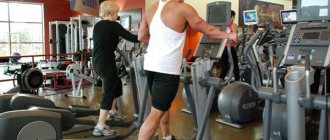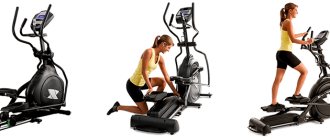Exercises on the elliptical trainer - Training rules
Pulse counting
To exercise with maximum impact, you need to calculate the heart rate you need. You can do this as follows: you need to subtract your age from 220. This will be your maximum recommended heart rate. In this case, the average value will be 60-70% of the obtained figure. Look at the indicators for your age:
However, these are all just indicative figures. There is no need to cling to them.
So, at first, we recommend increasing your heart rate gradually, since a sharp jump can put an excessive load on your body. And even more so, in the first stages, the first week or two of training, you do not need to use the interval method, in which your heart rate rises to maximum values. This way you will only harm yourself and enter a state of overtraining, that is, you will reach the point of physical exhaustion, after which you simply will not want to continue the training you have barely begun.
Basic body positions during training
One of the manifestations of the orbitrack’s versatility is that you can change your body position during exercise. When choosing the desired position, you focus on certain muscles, or use them in a different way. You can use both static handles of the exercise machine, focusing on the legs, and moving ones, using all the muscles of the body.
Torneo Festa C-320
The classic orbital position loads all muscles more or less evenly. Classic walking involves a number of rules:
- Straighten your body, round your chest, look forward, bend your knees. Place your hands on top of the movable handles of the machine.
- Watch your breathing: breathe from the diaphragm, not from the chest, so that your breathing is not intermittent.
- The body should move naturally, as if following your hands.
When moving backwards, you need to bend your knees more than usual. In this version, the main load goes to the buttocks. You can bend forward while holding the fixed handles. This way the emphasis will be on the quadriceps and calves. Another variation is the back bend. You need to kind of sit down and pedal in this position. This will specifically “hit” your gluteal muscles.
Speed
In order to progress, you must definitely adjust the speed on the orbit track. A lot of people start their training at a low speed. And this is correct, because you need to prepare your body gradually. But the problem is that they remain at this pace.
Increasing your running speed leads to faster metabolism, and therefore more effective fat burning.
Interval training using the Tabata protocol
The system is named after the Japanese sports doctor Izumi Tabata. It appeared in the mid-90s. Over the long experience of his work, Tabat has found a method of training with aerobic and anaerobic exercise, which is effective in two directions:
- fat burning;
- muscle building.
The idea is to perform certain exercises for 20 seconds, then repeat after 10 seconds of rest. The same pace must be maintained all the time. The muscles must not be allowed to cool down. One complex lasts 4 minutes.
The Tabata protocol was originally designed for use on an exercise bike. But later it was adapted for different types of fitness. Tabata interval training is great for doing on an elliptical machine. The main thing is to maintain high speeds and tempo. During training you will have to squeeze out all your strength.
Tabata training on an elliptical machine is based on the following principle:
- First, all joints are warmed up . It can be carried out on the “ground”. Then spend 5 minutes on the machine at a slow pace, gradually increasing to medium to bring your heart rate to the desired aerobic level.
- The main part is 6-8 cycles of 4 minutes . In each cycle, there is an alternation of fast and slow tempos of rotation of the pedals and handrails: 20 seconds of work and 10 seconds of rest. rest means a slow pace.
- The workout ends with a cool-down for 5 minutes . The tempo slowly decreases from medium to slow.
At the end, you can do several stretching and breathing exercises.
The advantages and benefits of interval training on the elliptical according to the Tabata protocol are as follows:
- Catecholamine, that is, a stress hormone, is released into the blood. The body intensively tries to cope with stress, so it actively burns calories and fat.
- Metabolism accelerates.
- Calorie consumption and oxygen consumption increase sharply. Moreover, even after stopping training, these processes continue for another 12 hours.
- Fats in the body are burned more actively.
An example of cardio training on an elliptical trainer at home.
Example of cardio training at home:
- Do a warm-up, more on that below.
- Move your pelvis back, tilt your body forward (to emphasize your buttocks), and pedal backwards. Keep the speed at medium. Place your hands on static handrails – 10 min.
- Now perform the same movement, only pedal forward. You will feel that the load on the buttocks is changing slightly - 10 minutes
- Switch to regular, classic walking and do the same for 10 minutes at an average pace.
- Increase your speed to maximum and run like this for 1 minute .
- Go for an easy walk, which will serve as a cool-down for you. If you feel the strength to continue, then repeat the cycle of maximum speed - walking for as long as necessary.
How to properly exercise on an elliptical trainer in the gym
Here's an example of a cardio workout using the interval training method:
- Warm up properly for 5 minutes ;
- Walk at a calm pace for 2-3 minutes ;
- Then go into running mode at a pace of 60-70% of the maximum - 5 minutes ;
- Go to maximum speed mode - 1 min ;
- Go for a walk to recover - 2-3 minutes ;
- Then start running again and repeat this cycle as long as necessary.
Duration of intervals
The duration of alternating intervals on the elliptical trainer is selected depending on the level of physical fitness. On average, moderate and intense paces last 2-4 minutes. Moreover, rest intervals (i.e. movements at average speed) should be longer than the main working ones.
For example, a person moves at a moderate pace for 4 minutes, followed by maximum acceleration for 3 minutes. Or the exercises are performed for an average of 3 minutes, and then the intense load is 1 minute.
If preparation allows, then the intervals of fast and slow load can be the same.
Elliptical training programs
For newbies
The key point here is to gradually enter the training process. Therefore, we recommend training 3 times a week at first. The first workout may last 15 minutes. Add 5 minutes with each next one. And this is where your calculated heart rate comes in handy: exercise within 60-70% of your maximum.
How to use an elliptical trainer for beginners
It is very tempting to jump straight into intense training, but we strongly recommend training in this mode for at least a month.
Interim program
After you have gained experience and pumped up your endurance, you can move on to the next level of training. We recommend at least 4 classes per week. Your heart rate should be on average 70-80% of maximum. At this stage, you can move on to the interval training method that we talked about here.
Program for the prepared
At this level, you can confidently train up to 6 days a week. However, the duration of training should still not exceed 60 minutes. By this time, your body has achieved sufficient endurance to exercise at 80-90% of your maximum heart rate. The practice of interval training may vary slightly, for example, you can reduce the duration of each period to 60 seconds.
Diet
It is not enough to know how to properly exercise on an elliptical trainer to quickly lose weight without compromising your health. Additionally, you need to follow the correct diet before and after.
It is recommended to eat no later than 2 hours before starting exercise. The diet should be rich in protein and vegetable products. To reduce the stress on your cardiovascular system, you should not drink coffee before using the elliptical trainer.
If you are interested in how to lose weight on an elliptical trainer, then you should eat no earlier than 2 hours after exercise. If you eat before this time, the food you eat should contain 2 times less calories than you burned during exercise.
Types of walking on an ellipsoid
Another manifestation of the versatility of the orbitrek is that it involves a variety of types of walking. Each type differs in which muscles are emphasized and how:
Classic walking , the rules of which were described above, systematically tones all muscle groups that can only be involved in the orbit: legs (calves, thighs, buttocks), arms (triceps and biceps), core muscles (abs, back, chest) and deltoids muscles. See what muscles are pumped when training on an elliptical.
In order to feel and use your muscles a little differently, we recommend trying reverse pedaling . In this case, the gluteal muscles are targeted. It is necessary to tilt your body slightly forward and bend your knees more than usual.
By leaning forward , you use your thighs and calves more. In this case, your hands need to be placed on fixed handles. The pedals are pressed harder into the floor, which creates additional stress on the leg muscles.
Bend backwards emphasizes the load on the buttocks. The back is kept straight, the pelvis is pulled back. Hands should be placed on the static handles of the orbitrack. It's like you're walking while sitting.
Common mistakes when exercising on a stepper machine
Many people think that “stepping” on a stepper is easy and simple. But in fact, beginners often make mistakes in exercise programs, and then complain about the lack of the desired result. An incorrect approach leads to painful sensations (back, knees) and muscle stiffness.
Main mistakes:
- valgus movement (bringing the knees together). The knees should move parallel; at the slightest hint of approaching, force is applied and this is not allowed. Otherwise, it’s easy to get sprained ligaments, dislocations, or tendon ruptures.
- toe kicks. When walking on a stepper, you need to push off from your heels, then the load on the gluteal muscles will be stronger
- emphasis on hands. When training on simulators with handrails, some trainees rely entirely on their arms and transfer the main load to them. This is wrong, since the muscles of the buttocks and legs remain without load.
When practicing on a stepper without handrails, your arms are usually lowered down. This is a mistake; it is better if you use them simultaneously with your legs: swing them, lift them up or to the sides when walking. If the exercise machine has handrails, then the body must be tilted forward, while not transferring the entire load to the hands, but only part of it. The small pelvis is pulled back, the lower back is slightly bent. From the outside, as well as in videos and photos, such exercises look a little funny, but these are the poses that give the best results during exercise.
Types of training
In order to progress on the orbitrek, you need to engage in different types of training. But at the very beginning, we recommend training according to the classical scheme, and only then, when you gain the necessary experience and prepare your body, move on to interval training.
Classic training program
This program involves training according to the following scheme.
- Warm up properly to avoid injury due to unprepared muscles for stress. Perform basic exercises on the muscles involved during training on the orbit track: do squats, rotations with your arms and body, and bending. Or you can warm up on the machine itself, but using an easy pace.
- Start with the exercises themselves. Use a pace of 60-70% of your maximum. Use different inclinations, reverse rotation, or work in the classic position: focus primarily on your needs.
- At the end of your workout, do a short cool-down using the same simple exercises described in point 1.
Interval training
Interval training involves alternating periods of training that differ in duration (periods can last either different or the same amount of time) and intensity (one period is at a slow pace and the other at a fast pace).
The advantage of interval training is that it trains cardiovascular and respiratory endurance, and also burns more calories than a standard workout. This occurs due to the following mechanism.
When you exercise, your body uses up its glucose reserves. But its amount is soon completely consumed, after which the body switches to glycogen located in the muscles. Then, finally, its reserves come to an end and the “burning” of fat deposits comes into play.
If the training intensity is insufficient, the body does not reach the third stage and only uses glucose and glycogen. This is why we need interval training. However, as previously warned, there is no need to immediately switch to this type of training; first give the body time to adapt.
Also, interval training is prohibited for people with cardiovascular diseases.
If we talk about the training itself, then you need to decide on the duration of the interval depending on your physical fitness. Typically each period lasts up to 5 minutes. In this case, at first the intensive period should be much shorter than the moderate one. For example, you can run 5 minutes at a medium pace and a minute at an intense pace. Then the difference may decrease as you gain experience and increase stamina.
Benefits of Interval Training
Interval training on the ellipse
has certain advantages over classes at a constant pace. The advantages of this mode are:
- increased muscle tone, increased body elasticity;
- high efficiency of weight loss;
- improved nervous system response;
- strengthening the cardiovascular system;
- increasing endurance.
Interval training on the elliptical accelerates the rate of cellular enzymes, therefore increasing the rate of energy consumption. A person begins to lose weight even in his sleep . Plus, the “metabolic furnace” is launched, or metabolic processes are accelerated, that is, even after stopping training, the body continues to use up fat reserves.
The fact is that this is an unusual load that creates stress for the muscles. They begin to expend calories intensively to replenish their energy reserves. As a result, they pull it out of lipid depots.
Finally, interval training on the elliptical is much more interesting, time flies faster.
Nutritional Features
If your primary goal is to lose weight by working out on an elliptical, then you cannot ignore the issue of nutrition. After all, no matter how diligently you work out on the exercise machine, burning a lot of calories every day, you will not see the results in the mirror if you continue to “throw in” the first thing you find in the refrigerator and do not care about your diet.
Therefore, first of all, we recommend establishing for yourself a certain scheme for improving your nutrition, which, coupled with competent training, will give excellent results. We recommend reading the article: Proper nutrition when training on an elliptical.
You need to reduce the amount of carbohydrates you consume every week. First of all, you need to get rid of the so-called fast carbohydrates. They are found in flour products, all kinds of sweets, and also in fruits. Moreover, if the latter in moderate quantities do not harm you, then the former should be excluded from the diet unconditionally.
The main type of carbohydrates that you will need to consume and gradually reduce are complex carbohydrates contained in foods such as pasta, buckwheat, and cereals.
But do not immediately chase quick results - this will only harm your body. Reduce carbs once a week a little at a time. Don't try to lose a few pounds in a week. Normally, you should “lose” 300-500 grams per week.
How to properly exercise on an elliptical trainer for weight loss?
How to start working out on an elliptical trainer?
Cardio exercise is good for good health and maintaining a beautiful figure. True, it is not recommended for a person with poor physical fitness to start too abruptly. It is necessary to gradually increase the load, this is important to avoid injuries to a body that is not accustomed to training. If you have not previously exercised intensively and suddenly decided to try orbitrek in action, then it is optimal to start with 3 classes a week, 30 minutes each. You will definitely feel when you adapt to the loads. Then you can train for 45 or 60 minutes.
How often do you exercise on the elliptical?
Most specialists adhere to this scheme: 2-3 workouts per week, each 50-60 minutes. The thing is that one of the goals of exercise is to effectively burn calories. Any activity burns them out. To lose weight, you need to burn more calories than you get from food and drinks. The proposed training scheme accomplishes this task. It's also a good idea to exercise 4 times a week. 1 session - about half an hour. This approach also successfully burns calories.
How long to use an elliptical trainer for weight loss?
The average duration of one workout is 1 hour. In each case, the effect of burning calories is different, it is influenced by the individual characteristics of the human body, heart rate, breathing method, body weight and other factors. If you work for an hour at different speeds, you will burn this amount of calories, on average from 300 to 700:
- training at a speed of 27-30 km/h - from 590 to 730 kcal;
- 22-25 km/h - from 485 to 600 kcal;
- 19-20 km/h - from 370 to 480 kcal;
- 15-16 km/h - from 275 to 355 kcal.
An important point: for a good figure correction effect, the body must work actively for 30-40 minutes, and after this threshold fat burning begins.
How many calories are burned on the elliptical during a workout?
The best models of exercise equipment are equipped with a calorie counter. The system gives an approximate amount and you don’t need to bother with counting. If this is not possible, then you can do the calculations yourself. In general, you should build on this: in half an hour of productive work on the simulator, you can burn about 6 kcal per 1 kg of body weight. If the workout is extended from 30 to 60 minutes, then 12 kcal will be burned per 1 kg of weight. To burn maximum calories, you do not need to lean on the handles of the machine and it is better to increase the resistance of the structure. Here are approximate data for 30 minutes of training, depending on body weight at moderate load and high intensity movements:
- weight 50 kg - 250 kcal;
- 55 kg - 270 kcal;
- 60 kg - 310 kcal;
- 70 kg - 350 kcal;
- 85 kg - 400 kcal.
Start from the fact that it is safe to lose 0.5 kg per week. If there is a large amount of excess volume - 2 kg. To lose half a kilogram, it is enough to properly organize your nutrition so that a weekly deficit of 3500 kcal is created. You can also undereat 1750 kcal and burn another 1750 during training. For example, your weight is 85 kg. Then for a week, conveniently distribute 5 workouts of 30 minutes or 9 workouts of 15 minutes.
What muscles work when training on an elliptical?
A modern simulator called an ellipsoid is a unique apparatus that forces a huge number of muscles to work intensively; we list the most important ones:
- hamstrings - these can be loaded more or less heavily using adjustments on new models;
- calves - for more active work of the calves, you should bend forward and grab the static handrails;
- chest, triceps - these muscles are activated when the movable handles are used;
- thigh (quadriceps) - the back and front areas of the thigh work;
- buttocks - girls who exercise on the orbitrack have beautiful, pumped up gluteal muscles, they are recommended to move the pedals backwards;
- back, biceps - if desired and the appropriate setting of the simulator, all these important muscles are activated, which benefits people with a sedentary lifestyle;
- abdominal area and internal organs - the deep muscles of the organs are involved;
- the heart muscle works - its training improves blood circulation and protects against heart disease.
Is it possible to lose weight by working out on an ellipsoid?
Of course, with the help of an orbitrek you can tighten your figure, strengthen your muscles and lose weight. You need to know one thing: the machine itself will not do much if there is no additional effort. These include other workouts. For example, basic strength exercises such as:
- crunches;
- pull-ups;
- pushups;
- different variations of squats.
The best effect can be achieved if you create a strength complex individually. It should be repeated several times a week. Complete your strength exercises with elliptical training.
How to lose weight on an elliptical trainer?
We will discuss further what exactly needs to be done to achieve weight loss. In addition to the elliptical projectile, the following items are needed:
- constant proper nutrition (not starvation diets, not time, but a healthy and rich diet forever);
- a well-thought-out daily routine (you need to find a place for training, work, rest);
- use of food supplements (there are many vitamin-mineral complexes and dietary supplements).
After each session on the orbitrek, a short cool-down is needed so as not to stop abruptly, this is undesirable for the heart. Proper nutrition with increased protein intake is extremely important. And at the same time, you need to remove everything harmful and limit simple carbohydrates and useless sweets as much as possible.
To make your diet rich, you can choose the right supplements. For example, multivitamin preparations, protein shakes and L-carnitine are popular today. We eat an hour before training and wait 2 hours after fitness. To support the body you need to drink enough clean water. With this approach, you will be able to remove excess volume from your figure and become visually slimmer.
the elliptical trainer perfectly works different muscle groups and promotes weight loss
Contraindications
Orbitrek is an excellent simulator for maintaining your health at the proper level, as well as pumping it up: it trains the endurance of various body systems.
However, like any other exercise machine, it can cause harm if you are not responsible about your fitness level before using the machine for the first time. There are a number of medical contraindications, without ensuring the absence of which, it is better to postpone training. We have already touched on the topic of contraindications to training on an elliptical trainer.
Among them are:
- hypertension with a tendency to periodic exacerbation;
- acute infectious diseases;
- oncological diseases;
- diabetes;
- thrombophlebitis;
- tachycardia and other heart problems.
We strongly recommend that you refuse to exercise on the orbitrek in case of any of the listed diseases. Other physical activities may be suitable for you, but for this you should consult with your doctor.
How much do you need to do on the elliptical to lose weight? Basic training programs by intensity
You should not run ahead of the locomotive either on a treadmill or on an elliptical. You can’t even imagine what the real percentage of disappointed people are who, after purchasing a simulator or buying a gym membership, write depressing reviews that their heart rate has been disrupted or their blood pressure has jumped.
Before you get on the elliptical trainer, find out how to exercise correctly, and be sure that this sports unit will only bring you benefits. How to start? At first.
Basic training
Start with the very first elliptical program if the last time you played sports was at school, or if you are recovering from a serious injury or illness. Don't let the word "basic" confuse you. This workout for beginners will be more than intense and before you complete it, you may well break seven sweats.
• Preparatory stage. The first thing you need to know about the elliptical trainer is how to properly warm up before training. Short squats, push-ups, bending to the sides and forward will help the body adapt to the upcoming load. • Warm up. Having stood on the simulator and taken the starting position, which we described above, calmly pedal for 5 minutes. • The next stage of the ellipse program is called warm-up. Subtract your age from 220 (for example, you are 40 years old). In this case, we get the number 180 - this is your maximum heart rate during training. During warm-up, heart rate should not exceed 50% of the maximum. Keeping your heart rate around 90 beats per minute, pedal quietly for another 10 minutes. • The new phase of the training will last a full thirty minutes. You need to alternate between 50% (for 4 minutes) and 70% (for 2 minutes) of your maximum heart rate. Increasing your heart rate is very simple - you start pedaling more intensely. Attention! Do not take your heart rate beyond 126 beats per minute (if, as already said, you are 40 years old). • And finally, cool down - work calmly on the machine, watching how your heart calms down and your heart rate decreases.











